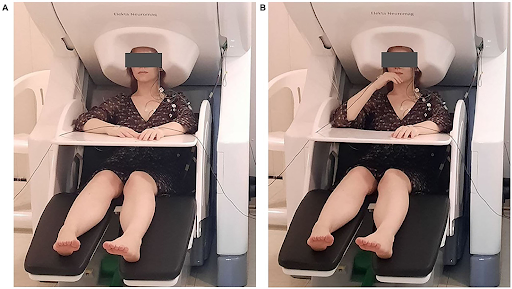Brain Stimulation May Facilitate Rehabilitation of Children with Arthrogryposis

HSE academics joined researchers from the Turner Scientific Research Institute for Children's Orthopaedics to study how the brains of children with arthrogryposis control elbow flexion after muscle transplantation. They found that in such patients, more motor neuron activity occurs, which means that the start of a new movement requires more effort from the brain. The paper ‘Feasibility and Challenges of Performing Magnetoencephalography Experiments in Children with Arthrogryposis Multiplex Congenita’ was published in Frontiers in Pediatrics.
The study is being carried out as part of a Russian Science Foundation grant headed by Iiro Jaaskelainen, Academic Supervisor of the International Laboratory of Social Neurobiology.
Arthrogryposis is a congenital disorder of the musculoskeletal system that causes deformation of extremities, underdeveloped joints and muscles, and limited movement. One in 10,000 newborns is born with arthrogryposis multiplex congenita (AMC). The disease does not progress with age and does not affect a child’s cognitive abilities.
For people with arthrogryposis, it is important to restore the ability to bend the elbow, which may help the individual to take independent care of themselves. This is facilitated by the transplantation of muscles capable of controlling elbow flexion. In such cases, it is necessary to teach the patient’s brain to control the extremity in a way that was previously not possible. The brain does not know this pattern of movement, as it had not previously been produced by the individual in their daily activities.
The study of brain activity related to elbow flexion enables the development of effective methods to rehabilitate people with arthrogryposis after muscle transplantation. Such studies have rarely been done on children, despite the fact that from year to year the age at each patients undergo autotransplantation surgery decreases, and more information is needed about the young AMC patients’ brain activity which can significantly differ from that of adults.
To bridge this gap, scholars from the HSE Institute for Cognitive Neuroscience studied the sensory-motor function in AMC children as compared with healthy age-match controls and adults. They invited four children with AMC and five healthy children aged 5–10 to the joint MSUPE-HSE MEG Centre equipped with a unique 306-channel magnetoencephalography (MEG). Three of the four children with arthrogryposis had previously gone through muscle transplantation surgery to restore elbow flexion.

Participants of the experiment were asked to sit at a table and bring their hand toward their mouth after hearing a voice command from a researcher, imitating the process of feeding themselves. Meanwhile, their brain activity was recorded using MEG. Each participant was asked to perform 80 movements—40 with each hand.
Combined MRI-MEG analysis of the sources of the brain activity showed that in patients with arthrogryposis who had undergone muscle transplantation, the bilateral cortex activation accompanying the hand movement prevailed as compared to contralateral activation in healthy control. Also, in AMC patients, the cortical sensory-motor activity was less constrained to the physiologically relevant areas of sensorimotor cortex in comparison with healthy children and adults.
Meanwhile, AMC movements were less precise and slower compared to healthy control groups.

Evgeny Blagoveshchensky, the co-author of the study and Senior Research Fellow at the HSE Institute for Cognitive Neuroscience
‘Bilateral cortex activity can be explained by relative difficulty of initiating movement by children with motor disorders: AMC patients with arthrogryposis might have to engage more motor neurons in this task.’
The brain activity dynamics in AMC patients was different from that in healthy control groups: the brain responses to movement extended over a greater amount of time. The slower the patient’s movement movement, the more extended the pattern of summarized the activity accompanying it. This is likely due to the involvement of a complicated compensatory mechanism in the elbow flexion process.
According to the researchers, since starting a movement is most difficult for children with arthrogryposis after muscle transplantation, possible rehabilitation strategies may include non-invasive brain stimulation, which would make it easier for them to start the movement.
Evgeny Blagoveshchensky
Senior Research Fellow, Institute for Cognitive Neuroscience
See also:
‘Scientists Work to Make This World a Better Place’
Federico Gallo is a Research Fellow at the Centre for Cognition and Decision Making of the HSE Institute for Cognitive Research. In 2023, he won the Award for Special Achievements in Career and Public Life Among Foreign Alumni of HSE University. In this interview, Federico discusses how he entered science and why he chose to stay, and shares a secret to effective protection against cognitive decline in old age.
'Science Is Akin to Creativity, as It Requires Constantly Generating Ideas'
Olga Buivolova investigates post-stroke language impairments and aims to ensure that scientific breakthroughs reach those who need them. In this interview with the HSE Young Scientists project, she spoke about the unique Russian Aphasia Test and helping people with aphasia, and about her place of power in Skhodnensky district.
Neuroscientists from HSE University Learn to Predict Human Behaviour by Their Facial Expressions
Researchers at the Institute for Cognitive Neuroscience at HSE University are using automatic emotion recognition technologies to study charitable behaviour. In an experiment, scientists presented 45 participants with photographs of dogs in need and invited them to make donations to support these animals. Emotional reactions to the images were determined through facial activity using the FaceReader program. It turned out that the stronger the participants felt sadness and anger, the more money they were willing to donate to charity funds, regardless of their personal financial well-being. The study was published in the journal Heliyon.
Spelling Sensitivity in Russian Speakers Develops by Early Adolescence
Scientists at the RAS Institute of Higher Nervous Activity and Neurophysiology and HSE University have uncovered how the foundations of literacy develop in the brain. To achieve this, they compared error recognition processes across three age groups: children aged 8 to 10, early adolescents aged 11 to 14, and adults. The experiment revealed that a child's sensitivity to spelling errors first emerges in primary school and continues to develop well into the teenage years, at least until age 14. Before that age, children are less adept at recognising misspelled words compared to older teenagers and adults. The study findings have beenpublished in Scientific Reports .
Meditation Can Cause Increased Tension in the Body
Researchers at the HSE Centre for Bioelectric Interfaces have studied how physiological parameters change in individuals who start practicing meditation. It turns out that when novices learn meditation, they do not experience relaxation but tend towards increased physical tension instead. This may be the reason why many beginners give up on practicing meditation. The study findings have been published in Scientific Reports.
Processing Temporal Information Requires Brain Activation
HSE scientists used magnetoencephalography and magnetic resonance imaging to study how people store and process temporal and spatial information in their working memory. The experiment has demonstrated that dealing with temporal information is more challenging for the brain than handling spatial information. The brain expends more resources when processing temporal data and needs to employ additional coding using 'spatial' cues. The paper has been published in the Journal of Cognitive Neuroscience.
Neuroscientists Inflict 'Damage' on Computational Model of Human Brain
An international team of researchers, including neuroscientists at HSE University, has developed a computational model for simulating semantic dementia, a severe neurodegenerative condition that progressively deprives patients of their ability to comprehend the meaning of words. The neural network model represents processes occurring in the brain regions critical for language function. The results indicate that initially, the patient's brain forgets the meanings of object-related words, followed by action-related words. Additionally, the degradation of white matter tends to produce more severe language impairments than the decay of grey matter. The study findings have been published in Scientific Reports.
New Method Enables Dyslexia Detection within Minutes
HSE scientists have developed a novel method for detecting dyslexia in primary school students. It relies on a combination of machine learning algorithms, technology for recording eye movements during reading, and demographic data. The new method enables more accurate and faster detection of reading disorders, even at early stages, compared to traditional diagnostic assessments. The results have been published in PLOS ONE.
HSE University and Adyghe State University Launch Digital Ethnolook International Contest
The HSE Centre for Language and Brain and the Laboratory of Experimental Linguistics at Adyghe State University (ASU) have launched the first Digital Ethnolook International Contest in the Brain Art / ScienceArt / EtnoArt format. Submissions are accepted until May 25, 2024.
Parietal Cortex Influences Risk-Taking Behaviour
Making decisions in situations involving risk and uncertainty is an inherent aspect of our daily lives. Should I obtain luggage insurance for my flight, cross the road when the light is red, or leave my current job for a new opportunity? Researchers at the HSE Institute for Cognitive Neuroscience conducted an experiment to clarify the role the parietal cortex plays in decision-making in the context of risk. They found that suppression of activity in the parietal cortex resulted in subjects being less inclined to take risks. A paper with the study findings has been published in Cerebral Cortex.


